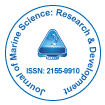Toxicity Evaluation of Common Drilling Fluid Additives and Applicability Comparison of Marine Toxicity Test Organisms
*Corresponding Author: Dr. Ren Huang, Guangdong Laboratory Animals Monitoring Institute, Guangdong Provincial Key Laboratory Of Laboratory Animals, Guangzhou 510663, China, Tel: 86(020)84106801, Email: Rhuang00@163.comReceived Date: Apr 03, 2019 / Accepted Date: Apr 22, 2019 / Published Date: Apr 29, 2019
Citation: Li J, Yu L, Liu W, Cai L, Hu Y, et al. (2019) Toxicity Evaluation of Common Drilling Fluid Additives and Applicability Comparison of Marine Toxicity Test Organisms. J Marine Sci Res Dev 9: 270.
Copyright: © 2019 Li J, et al. This is an open-access article distributed under the terms of the Creative Commons Attribution License, which permits unrestricted use, distribution, and reproduction in any medium, provided the original author and source are credited.
Abstract
The use of drilling additives has rapidly increased with the growing complexity of the drilling process. The environmental hazards associated with drilling waste have drawn a great deal of attention. It is, therefore, necessary to select eco-friendly drilling fluid additives and screen for suitable bioindicators. In the present study, toxicity tests were conducted in accordance with ISO 11348-1 (2007) and the Chinese national standards GB/T 21805-2008 and GB/T 18420.2-2009. Standard marine test organisms were used, including the bioluminescent bacterium Vibrio fischeri, marine diatom Chaetoceros muelleri, cladoceran Moina mongolica, anostracan Artemia salina, whiteleg shrimp Litopenaeus vannamei, and fish Mugilogobius chulae. The results showed that sulfonated asphalt and emulsifier 2 were the most toxic of the 26 drilling fluid additives tested, followed by White oil No. 3, anti-high temperature fluid loss additive, cleaning agent, and emulsifier 1. The order of species sensitivity to drilling fluid component toxicity was M. chulae>M. mongolica>A. salina>L. vannamei>C. muelleri>V. fischeri. A. salina, M. mongolica, and L. vannamei were significantly correlated with each other, as were V. fischeri and C. muelleri, while M. chulae was significantly and positively correlated with C. muelleri and L. vannamei. In conclusion, it was determined that M. chulae is suitable as a standard laboratory-reared organism for drilling waste toxicity assessments, followed by M. mongolica and C. muelleri. In view of their comparatively high toxicities, both sulfonated asphalt and emulsifier 2 merit further investigation and should be replaced by more ecologically benign products.

 Spanish
Spanish  Chinese
Chinese  Russian
Russian  German
German  French
French  Japanese
Japanese  Portuguese
Portuguese  Hindi
Hindi 